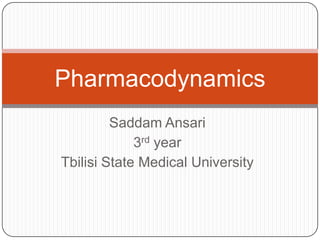
Pharmacodynamics
- 1. Saddam Ansari 3rd year Tbilisi State Medical University Pharmacodynamics
- 2. Objectives Pharmacodynamics Major Receptor Families Dose –Response Relationships Quantal Dose – Response Relationships
- 3. Pharmacodynamics Study of the biochemical and physiological effects of drugs on the Body Microorganisms Parasites within or on the body and Mechanisms of drug action and the relationship between drug concentration and effect
- 4. Continued… “Action of Drugs on the Body” Abbreviated as PD Effects on the Body (when drugs acts on body) ??? Stimulating action Depressing action Blocking action Exchanging action Direct beneficial chemical reaction Direct harmful chemical reaction
- 5. Continued… Desired Effect Cellular membrane disruption Chemical reaction with downstream effects Interaction with enzyme proteins Interaction with structural proteins Interaction with carrier proteins Interaction with ion channels Ligand binding to receptors
- 6. Continued… Undesirable effects Increased probability of cell mutation (carcinogenic activity) Interaction (additive, multiplicative, or metabolic) Induced physiological damage, or abnormal chronic conditions
- 7. Receptor Receptor is a molecule found on the surface of a cell, which receives specific chemical signals from neighbouring cells or the wider environment within an organism.
- 9. Ligands Is a substance that forms a complex with a biomolecule to serve a biological purpose. “Signal triggering molecules”
- 10. Ligand - Receptor Complex
- 11. Major Receptor Families Ligand-gated ion channels G protein- coupled receptors Enzyme-linked receptors Intracellular receptors Spare receptors Desensitization of receptors
- 12. Ligand-gated ion channels (LGICs) Are one type of ionotropic receptor or channel-linked receptor. They are a group of transmembrane ion channels that are opened or closed in response to the binding of a chemical messenger (i.e., a ligand),such as a neurotransmitter. An ionotropic receptor, when activated, directly affects the activity of a cell by directly opening ion channels.
- 13. Continued… Metabotropic receptor influences the activity of a cell indirectly by first initiating a metabolic change in the cell. This metabolic change may ultimately affect the opening or closing of an ion channel or may alter some other activity of the cell such as protein transcription.
- 15. G protein-coupled Receptors G protein-coupled receptors (GPCRs), also known as : seven-transmembrane domain receptors, 7TM receptors, heptahelical receptors, serpentine receptor, and G protein-linked receptors (GPLR)
- 16. Continued… Comprise a large protein family of transmembrane receptors that sense molecules outside the cell and activate inside signal transduction pathways and, ultimately, cellular responses
- 17. Classes of GPCRs Class A (or 1) (Rhodopsin-like) Class B (or 2) (Secretin receptor family) Class C (or 3) (Metabotropic glutamate/pheromone) Class D (or 4) (Fungal mating pheromone receptors) Class E (or 5) (Cyclic AMP receptors) Class F (or 6) (Frizzled/Smoothened)
- 18. Second Messengers Second messengers are molecules that relay signals from receptors on the cell surface to target molecules inside the cell, in the cytoplasm or nucleus. They relay the signals of hormones like epinephrine (adrenalin), growth factors, and others, and cause some kind of change in the activity of the cell.
- 19. Types of Second Messenger Hydrophobic molecules: water-insoluble molecules, like: diacylglycerol,and phosphatidylinositols, are membrane-associated and diffuse from the plasma membrane into the intermembrane space where they can reach and regulate membrane- associated effector proteins
- 20. Continued… Hydrophilic molecules: water-soluble molecules, like: cAMP, cGMP, IP3, and Ca2
- 21. Continued… Gases: nitric oxide (NO) carbon monoxide (CO) and hydrogen sulphide (H2S) (which can diffuse both through cytosol and across cellular membranes.)
- 22. Properties of Second Messengers They can be synthesized/released and broken down again in specific reactions by enzymes or ion channels. Some (like Ca2+) can be stored in special organelles and quickly released when needed. Their production/release and destruction can be localized, enabling the cell to limit space and time of signal activity.
- 23. Enzyme-linked Receptors An enzyme-linked receptor is a transmembrane receptor, where the binding of an extracellular ligand causes enzymatic activity on the intracellular side. They have two important domains: Extra-cellular ligand binding domain Intracellular domain The signaling molecule binds to the receptor outside of the cell and causes a conformational change on the Catalytic function located on the receptor inside of the cell
- 25. Examples of Enzymatic Action Receptor tyrosine kinase, as in fibroblast growth factor receptor. Most enzyme-linked receptors are of this type Serine/threonine-specific protein kinase, as in bone morphogenetic protein Guanylate cyclase, as in atrial natriuretic factor receptor
- 26. Intracellular Receptors Intracellular receptors are receptors located inside the cell rather than on its cell membrane. Examples are the class of nuclear receptors located in the cell nucleus and the IP3 receptor located on the endoplasmic reticulum. The ligands that bind to them are usually intracellular second messengers like (IP3) and extracellular lipophilic hormones like steroid hormones.
- 27. Intracellular Receptors : Types Steroid hormone receptor: Sex hormone receptors (sex hormones) Estrogen receptor (α and β) Androgen receptor (one type) Vitamin D receptor (vitamin D, one type) Glucocorticoid receptor (glucocorticoids, one type) Mineralocorticoid receptor (mineralocorticoids, one type)
- 28. Continued… Thyroid hormone receptor (α and β) Retinoic acid receptor (vitamin A and related compounds); Peroxisome proliferator-activated receptors (PPARs, α, γ and δ) Retinoid X receptor Farnesoid X receptor Liver X receptor Constitutive androstane receptor
- 29. Spare Receptors Term used to describe the situation in which maximum tissue response occurs when not all the receptors of the tissue are occupied by the drug
- 30. Desensitization of Receptors The rapid signal attenuation in response to the stimulation of cell by agonists or an antagonists. Or, decrease in response due to over administration of durgs Adptation Refractoriness Down regulation It is of 2 types….